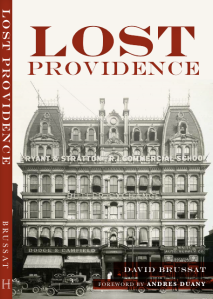 Downtown Providence as seen from northeast, from a spot on College Hill. For some reason, its skyline, which is best seen from the east, is nowhere pictured as viewed from the top of College Street on College Hill. Perhaps because the view of the Industrial Trust is obscured. (photo by N. Millard)
Downtown Providence as seen from northeast, from a spot on College Hill. For some reason, its skyline, which is best seen from the east, is nowhere pictured as viewed from the top of College Street on College Hill. Perhaps because the view of the Industrial Trust is obscured. (photo by N. Millard)***
Editor’s note: Here this blog resumes republication of chapters from Lost Providence, published in in 2017. I took a break from that series in order to write about pressing new matters. At that point I had published chapters 15-20, from Part II. I had decided not to republish Part I of the book. I may change my mind at a later date, but I should leave new readers with some reason to buy the book, right! I resume today with the first half of Chapter 21, “Waterplace and WaterFire.” Please excuse the absence of this editor’s note in last night’s post. WordPress forced me to switch from the effective WordPress app to something called Jetpack, which was a train wreck in progress. I am still working with their chat people to get it fixed. Wish me luck! Here is the first half of that chapter:
***
The encirclement of Waterplace Park by sterile modernism terribly degrades the experience of visiting the park, but objectivity requires admitting that in one sense even these buildings serve a useful purpose (aside from housing people and their activities). In surrounding the park with their bulk and height, they provide it with “walls” that transform the park into the sort of outdoor living room that best defines public space in a city. This creates the sense of enclosure that people crave in a civic square.
But even this service might have been inadequate to the needs of the park as a public space were it not for the extraordinarily attractive infrastructure designed by [the late] Bill Warner [The Rhode Island architect and planner hired by the state DOT to design the city’s new waterfront]. The soft edges of the pond; the many ledges to sit on; the rusticated granite abutments salvaged from the old embankments; the cobblestone pavements; the old and new stone of the walls between the multiple levels of walkways; the gentle arcs of the classically inspired bridges flanked by arched openings to passageways carrying river walks beneath twin pedestrian spans; the stylish and often witty embellishment of bollards, lampposts, tree grates and railings lining the rivers, walkways and parks – all of these humanist features forge both a conscious and an unconscious simpatico among the project, its buildings and the people who stroll amid its precincts.
 Steeple Street Bridge with its array of curves. (Photo by author)
Steeple Street Bridge with its array of curves. (Photo by author)These features serve as a saving grace at Waterplace Park, since they form an aesthetic bulwark against the glass-and-steel chill of the buildings that make up its outdoor room. The charm of the beauty that we walk by and see close up overwhelms the sterility of the buildings that occupy that western section of the waterfront. The “deep structure” of infrastructure softens the superstructure of Waterplace’s architectural build-out. It ties the two sections of the riverfront together, to the advantage of both. All these elements that save the bacon of the modernist western riverfront serve to lift its more traditional southern stretches to a degree of beauty unknown in contemporary waterfront redevelopment around the world.
Unlike the waterfront’s stretch along the Woonasquatucket, its stretch along the Providence sits between parts of the city fully built up for many years. Heading south from the confluence, a row of historic institutional and academic buildings along the east embankment, including Market House, heads into Memorial Park, whose central feature is the World War I monument by Paul Cret, relocated from Suicide Circle. The buildings that create the “room” of architecture around Memorial Park are Market House (1773); RISD’s College Edifice (1936); Providence County Superior Court (1933), with its cupola and its gabled wings climbing up College Hill; and the commercial buildings down South Main Street, starting with the counting house with the baroque ogee gable that was originally designed as his own residence by Joseph Brown in 1774, and concluding with the domed Old Stone Bank (1898) and its neighbor, the Benoni-Cooke House (1828).
 Old Stone Bank building on South Main Street, seen from Memorial Park. (Carol M. Highsmith)
Old Stone Bank building on South Main Street, seen from Memorial Park. (Carol M. Highsmith)The panorama of these buildings amply displays the symphonic aspirations of classical brick. As an accomplishment of two centuries of creative architectural craft, the cityscape of College Hill is downright inspirational. The clunker at its southernmost terminus, Old Stone Square, is insufficiently obnoxious to destroy the view. The building is tremendously obnoxious, but not enough so to ruin the masterpiece of its setting.
It is a setting that looks across the river to downtown’s Financial District, a crescendo of new and old towers that epitomizes what a city skyline should look like. This skyline has been remarkably stable, its last tower arising three decades ago, the Fleet Center – a postmodern building whose stepped gable is said to pay tribute to the Industrial Trust “Superman” Building (1928). Joined by the city’s first high-rise, the Banigan Building (ten stories, completed in 1896), the Turk’s Head Building (seventeen stories, 1913) and the Old Hospital Trust Building (eleven stories, 1919), the skyline’s modernist contributions are conservative, upstanding fellows that do their duty, contributing to the civic crescendo to the best of their ability, which reflects modern architecture at the utmost of its potential for achievement. They are the Textron Building (twenty-three stories, 1969) and the Hospital Trust Tower (thirty stories, 1974). The Textron’s windows are deeply recessed into a concrete-aggregate grid that rises with more solidity than the seemingly insubstantial glass and travertine of the Hospital Trust, which looks as if a stiff breeze could push it over. Yet both contribute admirably to the skyline – far more so, however, as seen from College Hill or downriver than from Kennedy Plaza or Waterplace Park. From the latter angles, the skyline seems less to lift the heart than to toe the line of march. (Oddly enough, it is this less-appealing angle that seems to enchant most of the city’s iconographers.)
 Providence skyline as viewed from the east, at Memorial Park. (Photographer unknown)
Providence skyline as viewed from the east, at Memorial Park. (Photographer unknown)Although the Providence River stretch of the waterfront runs through a mixed architectural environment of traditional and contemporary buildings, both the immediate vicinity and wider context are dominated by historical buildings. Thus the generally traditional elements of Warner’s waterfront design reinforce rather than undermine the dominant theme of the city, of diversity amid unity. It is very important to keep in mind that innovation, whether old or new, is baked into an environment in which those artists called architects paint beauty onto a canvas that evolves over generations of work, often with one building replaced by an even more attractive building. In turn, that context strengthens the allure of the waterfront infrastructure and all of its ornamental paraphernalia. Turning the pages of the several compilations of new waterfronts around the world, published over several decades by the Waterfront Center in Washington, D.C., one learns to appreciate the unique beauty of Providence’s new waterfront.
***
Editor’s note: That concludes the first half of Chapter 21, “Waterplace and WaterFire.” The next post will conclude the chapter.
 Providence skyline as viewed from top of College Street.
Providence skyline as viewed from top of College Street. Same view, circa 1940. Superior Court on left, RISD College Edifice on right. (Photographer unknown)
Same view, circa 1940. Superior Court on left, RISD College Edifice on right. (Photographer unknown)


Pingback: Waterplace and WaterFire | Structure Right here and There – Knowledge of world
With another opportunity for a beautiful park on the 195 land, your piece can provide some real guidance. Thanks David!
LikeLike
I suppose, Liz, that you refer to the park at the west end of the Van Leesten Pedestrian Bridge? I hope they don’t botch it by building a zany food hut of some sort!
LikeLike
We owe so much to Bill Warner’s brilliance as an architect and visionary. It’s important to remember
his aesthetic impact on Waterplace Park and other projects that he had a major role in conceiving.
There surely is a need for Providence to inform those who don’t know about the life’s work of Bill
Warner.
Professor emeritus Arthur Mark, FRSA
LikeLike
Yes, Arthur, so true. We can only guess what the waterfront might look like if Bill had not been around, with his design brilliance and his diplomatic savvy. But we don’t have to work too hard to imagine. All we have to do is look through the annual publication of the Waterfront Center, which I mentioned in that chapter. Each year they all compiled a photographic record of the major seaport, riverfront and other types of waterfront projects from around the world. They all stank to high heaven! All except ours. It was truly an amazing testimony to how automatically bad architecture has become internationally. Ugly has become the true International Style. We are so lucky here.
LikeLike
Nice article, Dave. I still hate that there is no real park on the basin but I enjoy sitting by the Memorial Park when I visit Waterplace. I never go up to the basin anymore unless there is a Waterfire which is in the title but I must have missed your mentioning it in the article. BTW, my first job was at AMICA. Fun seeing it in the picture but missed seeing Ron and Bill’s bridge. Trick photography to show the Robert Rowan bridge instead but keep up the good work. I love anything written about Waterplace even 26 years later.
LikeLike
Thank you, Rosalie. Unfortunately I had an editor’s note at both the top and the bottom of this piece, which were stripped out by WordPress, probably accidentally, as they forced me to switch from the WordPress app to something called Jetpack, which also initially stripped the illustrations. The WordPress app was good, at least for editing on my iPhone, but the Jetpack app has been a disaster. I guess its the old adage that an upgrade is a downgrade diguised as an upgrade, but the mask has slipped … Oy veh!
What is the Robert Rowan bridge?
LikeLike